|
|
Welcome to my travel log! You will find here a lot more than in the travel reports, stripped from political correctness. Enjoy! 
Oct 04, 2005 02:00 PM Kabaw (LY) - qasr of different kind
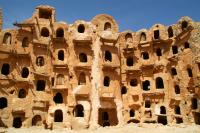 At Kabaw, there is a different type of qasr, I thought, when I saw it. Well, the previous one that I had seen, in Nalut, is actually
At Kabaw, there is a different type of qasr, I thought, when I saw it. Well, the previous one that I had seen, in Nalut, is actually
special. The ‘normal’ qasr was built as a vertical mud-brick tube, and the storage rooms were placed on its inner walls. The central
courtyard was empty to provide room for intermediate selection and preparation of the produce to be stored. Still the qasr at Kabaw is special. In addition to the unusually high six vertical levels it has also two underground levels with supplementary storage. In the centre of the courtyard, there a small building, which could have been used as a caretaker hut.
When I climbed to the top of the old city to see the granary, I was completely on my own. It was great! I could do what I wanted, looked where I wanted. The qasr is no longer in use and I am not sure if it is actually protected as a national treasure or
not.
|
Oct 03, 2005 02:00 PM Qasr al-Hajj (LY) - a great qasr
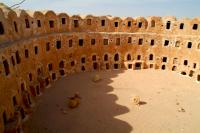 Certain literature stated that Qasr al-Hajj was the largest sample of Berber architecture in Libya, and possibly the most stunning. Well, I cannot say that I would agree to that. Yes, it is a great example of the medieval Berber architecture, but the old town is in total ruin, so I would argue that Nalut, for that matter, was any less striking. Hey, do not get me wrong, I really liked Qasr al-Hajj! It is the most complete one from that I saw, and the most uniform. The walls are complete and all storage rooms are in perfect condition. I liked the fact that there was a narrow walkway between the third and fourth levels. The oval courtyard in
Certain literature stated that Qasr al-Hajj was the largest sample of Berber architecture in Libya, and possibly the most stunning. Well, I cannot say that I would agree to that. Yes, it is a great example of the medieval Berber architecture, but the old town is in total ruin, so I would argue that Nalut, for that matter, was any less striking. Hey, do not get me wrong, I really liked Qasr al-Hajj! It is the most complete one from that I saw, and the most uniform. The walls are complete and all storage rooms are in perfect condition. I liked the fact that there was a narrow walkway between the third and fourth levels. The oval courtyard in
the middle had a few medieval items left loose, which was quite aesthetic. The qasr looks really impressive from the outside as well. It is situated within a small square among the restored part of the old town. The area has been gently redeveloped and there is even a small fountain in the middle of it, benches, palm umbrellas, and a bathroom! The qasr looks like a little castle,
or a small fortress. All around the outside walls there are very small windows, which really are just vents for the storage rooms.
But they really look like widows for rifles or lookout holes. When I came from the part of the totally ruined part of the old town to this redeveloped part, I felt really good. First, I thought that this fortified granary might still be in use, hence the local people decided to,keep the area clean for picnics and social,events. This is because the stricture of the, qasr looked like new. The main gate to the qasr was padlocked. There was no-one around, and I was not quite sure what to do. I did not really want to involve my driver, because he was quite lazy on this second day of Ramadan.
So, I decided to walk out of the old town and find someone in the new part, who might be able to help me find the key master. The man in his fifties got off and asked me in broken English if I wanted to see the granary. That was music to my ears. I paid LYD 4 for the tickets and was inside. I think this is the only qasr in the Jebel Nafusa area with an entry fee. I think it is right though, because the revenue is spent for the maintenance, which is necessary as the qasr suffers occasional damage from adverse weather. Qasr al-Hajj is of the same built as the one in Kabaw, but it has only four levels and no underground storage. It is larger in diameter and entirely complete, like it was built five
years ago. Well, this is a good thing, because the qasr has been in constant use since it was erected by As-Sheikh Abd-Allah ibn Mohammed ibn Hillal ibn Ganem Abu Jatla in the twelfth century.
|
Oct 03, 2005 02:00 PM Ghadames (LY) - UNESCO-listed medieval Berber town
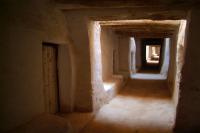 Perhaps the most famous Berber town anywhere in Northern Sahara, Ghadames, is also called the Jewel of the Sahara. I would definitely agree to that statement. There is absolutely no exaggeration here. The roofed streets and passage ways of this amazing town create inexplicable atmosphere and climate. I seriously find the right words to begin describe the place. I cannot really compare Ghadames to any other place I have seen in my life. It truly feels like you landed somehow in XIII century in the middle of a desert. When I was visiting the lighting of the passage ways did not work so my experience was authentic. Luckily when I let myself loose in the old town, there were absolutely no tourists around – only local people wandering around or attending prayers in the very old mosques. When I say that I let myself loose, I mean it all the way. I did not have any guide and I simply did know which way to turn and I did not care much if I get lost. There was always someone from the locals, who would be able to let me out of this amazing maze. In fact, after making two circles, I realised that it was not that hard to follow after all. Obviously, I had no idea what I was passing and what I was looking at, but it felt great to wander pointlessly in those dark passages. Every now and then, I ended up in a small
Perhaps the most famous Berber town anywhere in Northern Sahara, Ghadames, is also called the Jewel of the Sahara. I would definitely agree to that statement. There is absolutely no exaggeration here. The roofed streets and passage ways of this amazing town create inexplicable atmosphere and climate. I seriously find the right words to begin describe the place. I cannot really compare Ghadames to any other place I have seen in my life. It truly feels like you landed somehow in XIII century in the middle of a desert. When I was visiting the lighting of the passage ways did not work so my experience was authentic. Luckily when I let myself loose in the old town, there were absolutely no tourists around – only local people wandering around or attending prayers in the very old mosques. When I say that I let myself loose, I mean it all the way. I did not have any guide and I simply did know which way to turn and I did not care much if I get lost. There was always someone from the locals, who would be able to let me out of this amazing maze. In fact, after making two circles, I realised that it was not that hard to follow after all. Obviously, I had no idea what I was passing and what I was looking at, but it felt great to wander pointlessly in those dark passages. Every now and then, I ended up in a small
courtyard or an entrance to a mosque. Uh, in fact, names of certain streets in Ghadames, are unusually for Libya provided on the buildings in two languages – Arabic and English.
I walked for about an hour and a half taking, what I think are, some great photographs. The title page is equipped in exactly a picture taken in Ghadames. I tried not use the flash to capture the ambiance and the play of shadows in the passages. Yet, the
photos do not represent what it felt like to be there. Eventually, I ended in a small café called Dan Baro, which is based in a very pleasant garden of a traditional four hundred year old Berber house. The person behind the bar, offered me to see the house, of which I was rather curious. The house was very richly decorated in gold, red and white. The young man explained everything to me and even let me on the roof for a view. Well, I thought it was for a view, but actually he was trying to explain that in the past, women were not allowed in the streets so they were walking on the roofs. And by the way, the kitchen, for the convenience apparently, was also located at the top terrace of the house. Well, the view was great. It made it clear how the houses were connected, and showed that no inner street was visible from
the air. There are a few narrow streets leading to the gates of the city, but no inner street can be seen.
|
Oct 02, 2005 02:00 PM Nalut (LY) - annular eclipse and first qasr
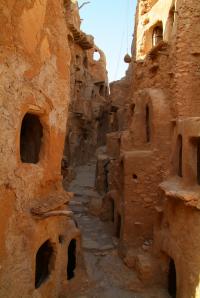 As I started to wander off, a middle-aged man spotted me and asked me if I was looking around the qasr. I said yes, and he invited me to his house. It was very basic and small, but had five rooms, four of which were the size of a double bed and 130 centimetres high, and the main one was about 2 metres high and could sit, say, seven people around. I mentioned that part of the qasr was locked and he quickly jumped out, reached for his key and took me there. As soon as he opened the door, I realised that I would have missed the main part and the actual granary! I was amazed with what saw. It felt so good that Libya continued to impress me. The qasr of Nalut is very special. It is like a small village within a village. The storage rooms are tightly packed close one to another and the passage around the qasr is very narrow, that even a donkey with a baggage would not fit there. Maybe without a baggage it would. Little light reached the palm-tree wooden doors of the storage rooms therefore. I had quite a difficulty to take a decent picture there. I learned that the purpose of the fortified qasr was to protect the groceries, dates,
As I started to wander off, a middle-aged man spotted me and asked me if I was looking around the qasr. I said yes, and he invited me to his house. It was very basic and small, but had five rooms, four of which were the size of a double bed and 130 centimetres high, and the main one was about 2 metres high and could sit, say, seven people around. I mentioned that part of the qasr was locked and he quickly jumped out, reached for his key and took me there. As soon as he opened the door, I realised that I would have missed the main part and the actual granary! I was amazed with what saw. It felt so good that Libya continued to impress me. The qasr of Nalut is very special. It is like a small village within a village. The storage rooms are tightly packed close one to another and the passage around the qasr is very narrow, that even a donkey with a baggage would not fit there. Maybe without a baggage it would. Little light reached the palm-tree wooden doors of the storage rooms therefore. I had quite a difficulty to take a decent picture there. I learned that the purpose of the fortified qasr was to protect the groceries, dates,
produce, grain and oil of the village people from looters, who often kept invading the villages in the middle ages of the XIII and XIV centuries. Later on, when an invasion occurred, the bandits could only rob the families of one week worth of produce, while the rest was safely locked in the granary. Each family of the village had one storage room. There are about four hundred of them in Nalut, and the keeper of the granary knew exactly how much each family had in their rooms at any time when asked. As I looked inside, I saw that some families are still using this facility. Not many, but the seven century tradition continues to this day, hence the site is kept locked. I also found the spot of the granary from the picture, so I was very happy. The day was coming to an end, sunset was approaching and the play of colours and shadows at the qasr made this quick escapade the highlight of the day.
As I descended from the plane in Tripoli I realised that I forgot to take my eclipse glasses from home. Well, I did not think much about it then and thought that it should be quite easy to get something usable in Libya. When I asked my tour guide if I could for example get the glass from a welding mask, he said that it was rather impossible. Then, I started to be a little concerned. Well, later on, when I was actually on my way to Nalut, I mentioned this to my driver, Khalifa, and he said that there could not be an easier job for him to find what I needed, because every second shop in Libya is a welding shop. It took him about five minutes to get me a couple of slabs of welding glass for one dinar each! So, I was prepared then, I thought. Not exactly! I still did not have appropriate filter for my camera to take the pictures. With total eclipse of the sun, no filter is necessary, but with an annular eclipse, the sun is still too bright.
The eclipse came at 11:22 local time (09:22 UT), and it was great. The air temperature dropped and the light was slightly subdued, almost like at about 6pm the night before. This was my first annular eclipse, and I must say it was completely different from the total eclipses. During totality, it becomes dark with twilight at the horizon, and all becomes very calm. The birds stop singling, and some hide their heads to sleep. At the annularity,
no such thing happens. The day is still bright, and beside a slight drop in temperature and daylight, one would not even notice there was a moon in the middle of the sun in the sky. So, I kept looking through my camera lens and kept taking pictures, changing the settings slightly. I have to say, that I am very happy with the results. And thank God for the Catalonians, who gave me the filter!
|
Oct 01, 2005 02:00 PM Abohamam (LY) - Berber houses
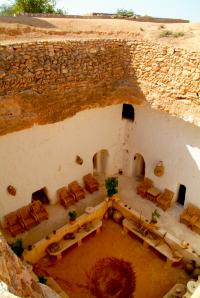 Not far from Gharyan, there is a place where two people, called Mosa Ahmed and Arabi Mohamed, restored an underground Berber house and started converting it into a hotel. They made a great job so far and they have great plans to develop it further. Now, the house looks almost like the one from Star Wars’ home of Luke Skywalker on the desert planet of Tatouan. Mosa Ahmed studied six years in Poland’s University of Economics in Wroclaw. So, I spoke with him in Polish. He was astonished how much he forgot of the language. He showed me around the house, which
Not far from Gharyan, there is a place where two people, called Mosa Ahmed and Arabi Mohamed, restored an underground Berber house and started converting it into a hotel. They made a great job so far and they have great plans to develop it further. Now, the house looks almost like the one from Star Wars’ home of Luke Skywalker on the desert planet of Tatouan. Mosa Ahmed studied six years in Poland’s University of Economics in Wroclaw. So, I spoke with him in Polish. He was astonished how much he forgot of the language. He showed me around the house, which
originally was home for eight families. Each family owned one dwelling of the house, and each dwelling was divided into
three parts. The front one was for the grandparents, the middle one was for children and the deepest part was for the parents. Although each dwelling had three parts, it was in fact one big room, and only the gentle arches on the ceiling marked the territory of the specific generation. Often, the parents had a little room at the back, which could be separated by a hanging cloth. The room could be used for making more children, I guess. Sometimes, a dwelling had also a storage room within it and most definitely a small hole immediately before the entrance, for a
hen to lay eggs. The entire house is authentic and the only modern things there are toilets and a shower, cleverly confined not to spoil the entire ambiance of the place. The guys are also planning to open a restaurant and a café in the immediate vicinity of the house. Oh, I forgot to say that the house, although actually in the ground (or underground), is located on a high hill, so the restaurant and the rooftop café will offer a magnificent view reaching as far Tripoli, some eighty kilometres away, plus an oasis at the bottom of the hill. Quite lovely, I have to say.
|
Sep 30, 2005 02:00 PM Leptis Magna (LY) - simply magnificent
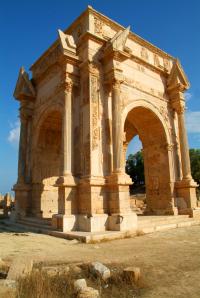 One of the most spectacularly preserved ancient Roman cities in the world, Leptis Magna (or Lepcis Magnae) took my breath away. I did not expect anything of the site, because I only saw a few close-up pictures of statues and one picture of the Roman Theatre, but not much more. And that was a good thing, because the city took me by surprise and I threw my imagination on my
One of the most spectacularly preserved ancient Roman cities in the world, Leptis Magna (or Lepcis Magnae) took my breath away. I did not expect anything of the site, because I only saw a few close-up pictures of statues and one picture of the Roman Theatre, but not much more. And that was a good thing, because the city took me by surprise and I threw my imagination on my
knees! The grand entry to the site is the Arch of Septimus Severus. It has been wonderfully restored and the result is mind-boggling! It makes such an impact that everything else that I had seen in the Mediterranean of this kind looked now bleak. The path from the entrance to the arch, which is located on much lower ground, does not reveal anything until the very last second and then it hits you! I simply could not believe my eyes. The arch is, for a lack of a better word, perfect. I met a few Italian people, actually Romans, and they admitted that they were overwhelmed by this arch. Their actual words were “We are from Rome, and we do not have this! This is exceptional!!”
Hadrian’s Baths of Leptis Magna were potentially the most magnificent place in the city and arguably the most extravagant baths in the Roman Empire. The baths contained several pools, sophisticated heating system for the steam rooms (sauna) and complex toilet. All was meticulously decorated with different variety of marble, perfectly sculpted statues and elaborate mosaics.
|
Sep 29, 2005 02:00 PM Benghazi (LY) - a nice and civilised town
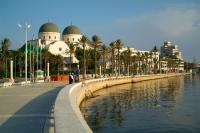 Libya’s second largest town was surprisingly pleasant with very well maintained seafront promenade. I definitely did not expect that having seen a few photos around. I only came to Benghazi as I had a little spare time before my flight back to Tripoli. I stopped only once to explore the Freedom Square with its majestic, although decaying rapidly, old town hall. It is a superb building with so much character, that I must have taken 30 photographs of it. Probably 25 too many, but I just wanted it photographed from every single angle. The building has a balcony, which played a very significant role in Libya’s history. Italy’s Mussolini, Third Reich’s Rommel and Independent Libya’s
Libya’s second largest town was surprisingly pleasant with very well maintained seafront promenade. I definitely did not expect that having seen a few photos around. I only came to Benghazi as I had a little spare time before my flight back to Tripoli. I stopped only once to explore the Freedom Square with its majestic, although decaying rapidly, old town hall. It is a superb building with so much character, that I must have taken 30 photographs of it. Probably 25 too many, but I just wanted it photographed from every single angle. The building has a balcony, which played a very significant role in Libya’s history. Italy’s Mussolini, Third Reich’s Rommel and Independent Libya’s
King Idris all spoke from it. The square also has a mosque, called Atiq Mosque, which wonderfully contrasts with the Italianate architecture of the rest of the square and the pedestrian precinct that leads to it. I found myself on the square in late afternoon, and all the shops around were already closed. Many kids were running around the place and as soon as they spotted me with my huge camera dangling from my neck, they asked for photographs. I obliged without hesitation. Some of the kids were so eager to be photographed but later on were too shy to have a look at my camera’s LCD screen for the result.
|
Sep 29, 2005 02:00 PM Ptolemais (LY) - ancient Greek site
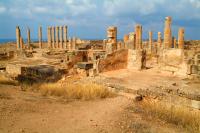 Ancient Greek city later transformed by the Romans, like all the other ancient cities in Libya. Only 10 percent is excavated, and the
Ancient Greek city later transformed by the Romans, like all the other ancient cities in Libya. Only 10 percent is excavated, and the
process takes a long time, because work only takes place two months a year. The Libyan government made deals with a number of universities around the world, which send their professors and students of archaeology to dig at the sites. Ptolemais is being taken care of by the University of Warsaw, Poland. Mosaics, which were found in Ptolemais are among the finest in Africa. I specifically went into the museum to see them, and I was astonished that from a distance they look like paintings. This is because their individual elements are smaller that one square centimetre.
Odeon, a Greek invention, which is a small stage for listening to the music was not an idea for the Romans. Romans preferred larger theatres for listening to the music on a larger square. The Greek enjoyed music in a more cameral atmosphere. Perhaps this is why the Romans transformed the Ptolemais’s Odeon into a swimming pool, six hundred years after it was constructed as a small concert hall. Cheeky bastards, because they could have easily built a swimming pool and leave the Odeon alone. For the first time, I was able to see very close and touch an ancient Greek statue. I simply could not believe how detailed and thoroughly sculpted it was. I think it was a statue of a soldier with perfect body, and it was sculpted in such a way, that every single muscle could be felt. It was amazing.
|
Sep 29, 2005 02:00 PM Cyrene (LY) - wonderful
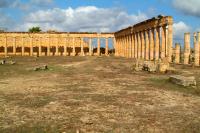 Legendary ancient Greek city of which
Legendary ancient Greek city of which
everyone must have heard. It is quite large
but there is a single thing that made the
most impression on me – the perfect
Gymnasium or Roman Forum. It is enclosed
by a line of columns running on the
rectangle of the piazza – see picture above. I
did not expect to see anything like that at
all! The two of the remaining magnificent
gates are also imposing.
The other place that screwed my imagination
was the Greek Agora, later transformed by
the Romans. It used to be the central square
of the city designed for the public. It is still a
superb place with outstanding statues and
temples. My favourite temple was the
Sanctuary of Demeter and Kore – the rulers
of the underworld. It is a round, small
building in which wonderful statues of the
goddesses stand.
Many locals say that it a miracle that neither
British nor Italians took the statues out of
there to populate museums in their
countries, like they did with many other
monuments of the antiquities.
The lower part of the city, the extensive
Sanctuary of Apollo, which boasts a large
temple of Apollo and smaller temples for
other gods and goddesses, is also
interesting, although it did not made as large
impact on my as the Gymnasium or Agora
did.
Sadly, the once great theatre fantastically situated on the verge of the escarpment has not been restored and it requires a stretch of imagination to see how wonderful it might have been. The temple of Zeus is undoubtedly the very highlight of Cyrene. One can always tell, which temple was for Zeus, because the size, or
specifically the thickness, of the columns is incomparable to any other in the area. I think the columns might be three times as thick as the ones at the temples for other gods. I thought this one at Cyrene was marvellous. Obviously, I went inside to soak the historyand the ambiance of the place. It was immense! When I was wandering around this gigantic temple, I again knew why I loved seeing those ruins in Libya. First of all, there was no-one else there but me and I could walk anywhere on the site and step on any stone! Cyrene is so large that one can struggle to find ones ways without a guide. It is a good half an hour walk from one gate to another, if downhill from the South-Eastern Gate. And one steps among unexcavated and partially excavated households, forums and piazzas. The city had four stages for performances within its walls. That says a lot about the size and importance of the place! Tombs in the escarpment around the ancient city add a curious variety to the ancient city. There are many of them, and in the past, there was one tomb per family. I did not go into any of them, but they are clearly visible from the road.
|
Sep 29, 2005 02:00 PM Apollonia (LY) - elegant
 I knew was about twenty metres from the ancient Apollonia, the Greek ruins with Byzantine influences, so I did not hurry, although I did want to catch the best light for my photos. I actually could see most of them from my balcony through the harsh morning sunrays. It is relatively small site yet hosting three great temples with gorgeous columns, and a Byzantine fort. There are also large slabs of marble lying around. Obviously, the majority of Apollonia is yet to be excavated, and large proportion lied underneath the sea, as the effect of the famous earthquake of the of 365. Until the excavation happens, the site appears poor in comparison with other ancient sites along the Mediterranean coast. Although the tall and straight standing columns impress and allow the mind to begin imagining how great those temples must have been. The temples are spread for about one mile, so Apollonia must have been an important city. I did not even go to the very end of it, where the amphitheatre is. It is because I forgot to take my map with me, and my ‘guide’ had absolutely no idea what to do there or what to see. It is such a pity that the ancient port has never been excavated from the sea, where all of it is – submerged and invisible. The guard only charged me the camera fee of LYD 5 and waived my entry fee, and I have absolutely no idea why. Maybe my greedy tour operator had something to do with it, I do not know.
I knew was about twenty metres from the ancient Apollonia, the Greek ruins with Byzantine influences, so I did not hurry, although I did want to catch the best light for my photos. I actually could see most of them from my balcony through the harsh morning sunrays. It is relatively small site yet hosting three great temples with gorgeous columns, and a Byzantine fort. There are also large slabs of marble lying around. Obviously, the majority of Apollonia is yet to be excavated, and large proportion lied underneath the sea, as the effect of the famous earthquake of the of 365. Until the excavation happens, the site appears poor in comparison with other ancient sites along the Mediterranean coast. Although the tall and straight standing columns impress and allow the mind to begin imagining how great those temples must have been. The temples are spread for about one mile, so Apollonia must have been an important city. I did not even go to the very end of it, where the amphitheatre is. It is because I forgot to take my map with me, and my ‘guide’ had absolutely no idea what to do there or what to see. It is such a pity that the ancient port has never been excavated from the sea, where all of it is – submerged and invisible. The guard only charged me the camera fee of LYD 5 and waived my entry fee, and I have absolutely no idea why. Maybe my greedy tour operator had something to do with it, I do not know.
|
Page:
 82 83 84 85 86 87 88 89 90 91 92
82 83 84 85 86 87 88 89 90 91 92

|
|
|
